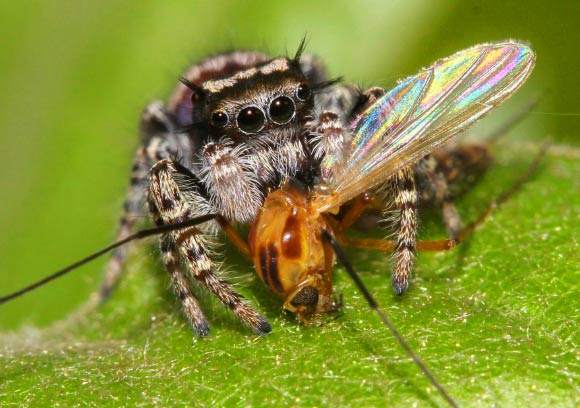According to a new study published in The Science of Nature, the annual prey kill of the global spider community is in the range of 400-800 million metric tons (fresh weight), with insects and springtails composing more than 90% of the captured prey.

Jumping spider Phidippus mystaceus feeding on a nematoceran prey. Image credit: David E. Hill, Peckham Society.
Spiders evolved from an arachnid ancestor during the Devonian period around 400 million years ago.
With more than 45,000 species and a population density of up to 1,000 individuals per sq. m., they are among the most common and abundant predators in terrestrial ecosystems.
Due to their secretive lifestyle — many spiders are nocturnal or live well camouflaged in vegetation, it was previously difficult to demonstrate their ecological role.
But Dr. Klaus Birkhofer of Lund University and Dr. Martin Nyffeler from the University of Basel have now used calculations to conclude that spiders indeed have an enormous ecological impact as natural enemies of insects.
The researchers used two calculation methods based on different models, which consistently showed that the global spider population (with a weight of around 25 million tons) wipes out an estimated 400-800 million tons of prey every year.
More than 90% of that prey are insects and springtails. Large tropical spiders occasionally prey on small vertebrates (frogs, lizards, snakes, fish, birds, and bats) or feed on plants.
“For a sense of just how much this is, take the following into account: all humans together consume an estimated 400 million tons of meat and fish annually,” they said.
“Whales feed on 280 to 500 million tons of seafood, while the world’s total seabird population eats an estimated 70 million tons of fish and other seafood.”
According to further calculations, spiders in forests and grasslands account for more than 95% of the annual prey kill of the global spider community.
The figure reflects the fact that forests, grasslands and savannas are less frequently disturbed than for instance agricultural or urban areas, and therefore allow for greater spider biomass.
“These estimates emphasize the important role that spider predation plays in semi-natural and natural habitats, as many economically important pests and disease vectors breed in those forest and grassland biomes,” Dr. Nyffeler said.
Spiders are not only important predators, but are also valuable sources of prey, according to the researchers.
Between 8,000 and 10,000 other predators, parasitoids and parasites feed exclusively on spiders, while spiders at the same time form an important part of the diet of an estimated 3,000 to 5,000 bird species.
“We hope that these estimates and their significant magnitude raise public awareness and increase the level of appreciation for the important global role of spiders in terrestrial food webs,” Dr. Nyffeler said.
_____
Martin Nyffeler & Klaus Birkhofer. 2017. An estimated 400–800 million tons of prey are annually killed by the global spider community. Sci Nat 104 (30); doi: 10.1007/s00114-017-1440-1







